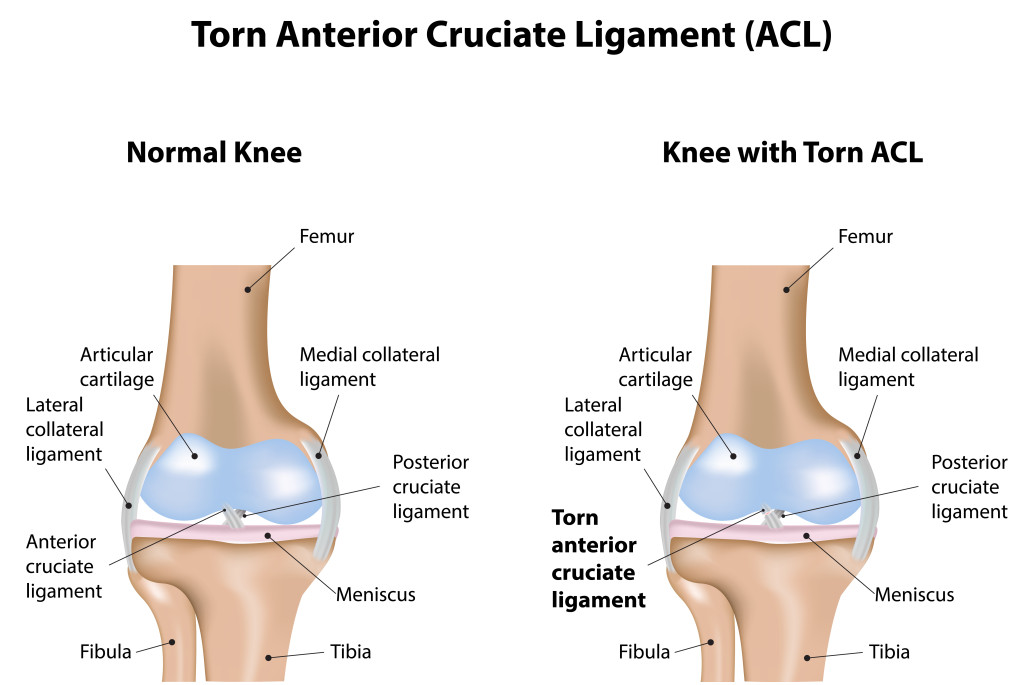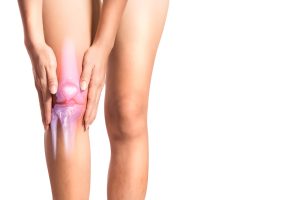ACL Tear Surgery in Burr Ridge
Also serving Plainfield, Morris and surrounding areas
| Procedure | • Arthroscopic, Outpatient • A new ligament is created using either your patella tendon or hamstring tendons to replace the torn ACL. |
| Duration | 1.5 hour |
| Anesthesia | General |
| Recovery | • Immediate full weight bearing. • Immediate physical therapy • Brace for 4 weeks • Return to daily activity as tolerated • Return to work depends on type of work • Full return to sports for athletes 8 – 10 months |

The ACL is a primary stabilizer of the knee joint. Without this ligament, the knee will be unstable and not allow side to side or pivoting motion in daily life or in sports. It will also predispose the knee to damage such as cartilage tears or arthritis. Loss of the ACL may even cause instability or giving way of the knee with daily life activities.
The ACL is torn in various ways and most commonly sports activity. The majority of tears occur without any direct blow to the knee, but rather with a hard landing from a jump, or a twisting, pivoting, or hyperextension force to the knee. Changing direction rapidly, slowing down when running, and landing from a jump are a few of the non-contact ways in which a person can tear the ACL.

When the ACL tears the athlete will experience a sharp pain and “pop” in the knee, followed by moderate or even severe swelling. Most people are not able to return to play at that time. The knee will typically quiet down over 1–2 weeks and may even feel completely normal for a period of time. This is usually followed by the knee giving way with any attempt at return to sport or even with turning or changing direction in daily activity. The presence of moderate or severe knee swelling after injury is always a serious issue and should not be ignored even if it dissipates within a week or so. Greater than 90% of the time this swelling represents internal bleeding from ruptured tissues inside the knee joint, and these are most commonly an ACL tear or a Meniscus tear.
Female athletes have been found to tear the ACL 5–8 times more often than males. Various factors influence this injury rate. There are many prevention programs that are offered and recommended for female athletes especially in soccer, basketball, and volleyball. The programs have been shows to be effective and should be a part of any young athletes workout routine.
Some patients who are not physically active or who do not experience giving way of their knee with daily life after tearing the ACL may consider being treated with exercise and bracing only. However, the vast majority of people with a torn ACL will require ACL Reconstruction to restore stability in the knee, and allow higher level function and stability with their everyday lives.
When the ACL tears it cannot be sutured back together and repaired. Therefore a new ligament must be constructed to replace it. This is what we refer to as ACL Reconstruction. ACL Reconstruction is an outpatient surgery lasting 1–2 hours in which a new ligament is created to replace the torn ACL using the patient’s own tissue (or in certain cases donated tissue). This is followed by a 4–5 month recovery and rehabilitation period before return to full sports. Daily activity is resumed to near normal within the first 2–4 weeks. This surgery is performed arthroscopically, allowing treatment of any other cartilage injury at the same time as the ACL reconstruction. This treatment allows people to return to their previous level of activity in 80%-90% of cases.
Much attention has been paid by surgeons and patients alike to the type of material used to create the new ACL graft. The two most equally reliable sources for making the ACL graft are the patient’s own patella tendon, or hamstring tendons, also taken from the patient’s own knee. There is some data which suggests that patella tendon may have a higher risk of development of osteoarthritis over the long term, but both graft sources provide excellent long term functional results. Over the last 15-20 years use of cadaver donated tissue (Allograft tissue) had been in vogue with the advantage of not having to use any of your own tissue. However, in the last 3-5 years the Orthopaedic research has very clearly shown that the risk re-rupture of the ACL when using Allograft tissue is unacceptably high and in the 25-30% range. For more complex injuries that include multiple ligaments being torn (such as ACL/PCL/LCL) allograft tissue can be used to avoid excessive surgical trauma to the patient. However, for a single ligament isolated ACL tear the preferred tissue is the patient’s own, either Patella Tendon or Hamstring.
Symptoms
Aside from a popping noise, individuals should pay attention to the following symptoms, as they can indicate an ACL injury:
- Pain near the back of the knee that radiates toward the side of the knee
- Limited range of motion in the knee
- Discomfort while walking or putting any sort of pressure on the knee
Injury Severity
Injured ligaments are categorized by level of severity.
Grade 1: In a grade 1 sprain, the damage to the ligament is minor. The ligament could be stretched but it is still capable of stabilizing the knee joint as it heals.
Grade 2: This type of strain describes ligaments that have been significantly stretched and are now loose. Partial ACL tears are rare, as most injuries to this ligament are complete.
Grade 3: Also known as a complete tear, this type of strain describes a ligament that has been either torn completely or separated from the bone, resulting in an unstable knee joint.
Risk Factors and Prevention
When too much pressure is put on the knee, or if it moves or twists more than it is naturally able to, you can experience an ACL injury. Common causes of ACL tears include trauma or injury from sports, car accidents, or serious falls. However, patients should know that there are certain factors that can make them more likely to experience ACL tears. Athletes who play sports that require sudden stops, direct contact, jumping, or frequent changes in direction are particularly prone to knee injury. These include sports include:
- Basketball
- Soccer
- Gymnastics
- Football
- Lacross
ACL Injury Complications
Unfortunately, when you sustain an ACL injury, other areas of your knee can be injured as well. These can include the medial collateral ligament, lateral collateral ligament, and posterior cruciate ligament. Some individuals may also experience bone fractures or tears in the meniscus at the same time as an ACL tear.
What to Expect During Your Examination
During your visit, Dr. Burt will discuss your symptoms and conduct an examination of the injured knee, checking its structures against your non-injured knee. Additionally, you may need other tests to confirm an ACL tear, such as an X-ray, which is ideal for indicating whether the knee injury stems from a broken bone, or an MRI, which produces high-quality images of the injured ligament. MRIs can also help Dr. Burt determine if other ligaments have been injured.
Treatment Options
ACL injury treatment options are based on factors such as the patient’s symptoms and the extent of the injury. Generally, options are categorized as surgical and nonsurgical:
Nonsurgical: Nonsurgical options are ideal for grade 1 sprains and may include bracing to help keep the knee stabilized. You may also need crutches during this time to reduce the weight placed on the knee. Additionally, physical therapy may be recommended to help heal and restore the range of motion in the knee. This can also help with strengthening the muscles in the leg that support the knee.
Surgical: Dr. Burt may recommend surgery to repair your ACL. This may be the best option if you expect to be physically active throughout life.
Knee ACL Tear FAQs
What if I ignore an ACL tear injury?

A complete tear of the ACL ligament typically requires a surgical solution, as the ACL does not heal on its own. Without a functioning ACL ligament in the knee, you will experience instability of the knee and be more susceptible to cartilage injury and ultimately arthritis of the knee. Symptoms of osteoarthritis may not appear for a decade or more, but at some point your lifestyle and comfort will be significantly impacted.
What are the benefits of arthroscopic surgery?
It wasn’t long ago that serious knee injuries required major surgery. Today, advanced arthroscopic technology in the hands of a skilled surgeon has changed the patient experience from one involving a hospital stay and prolonged recovery to an outpatient procedure that requires a few small incisions.
The arthroscope is a slender tube tipped with a tiny camera. When inserted into the knee joint, it allows a surgeon to see exactly what has happened to the interior structures of the knee. As such, it is a highly effective diagnostic and surgical tool. It provides real-time video that a surgeon uses to guide other small instruments inserted via small incisions to complete a reconstruction of the ACL ligament and also treat any torn meniscus or damaged cartilage.
This makes arthroscopy a minimally invasive method for a surgeon to repair damaged cartilage, ligaments, and tendons. It also makes it a convenient choice for the patient: For most arthroscopic knee operations, you will be home within hours of the surgery.
What happens after an arthroscopic procedure for an ACL tear?
After your arthroscopic surgery, you will spend some time in a recovery room and then be sent home with bandages on the small incisions with an ice wrap and a brace. Your joint will require some time for healing and rehabilitation.
Home exercises and a program of physical therapy will be important to a successful recovery. Early exercise can help preserve your range of motion, preventing a joint from becoming stiff as it heals. Your surgeon will tell you when it is appropriate to begin mild exercise, and when to start physical therapy.
What are the ways the knee can be injured?
Most knee injuries involve damage to cartilage, the flexible tissue that keeps the bones from rubbing together as a joint bends, or to the ligaments that stabilize the joint by preventing sideways movement and buckling. Muscles, too, play an important role in keeping the joint stable, and injuries to the leg or thigh muscles can result in improper functioning of the knee.
In the case of an ACL tear, the anterior cruciate ligament is ruptured. When this happens, it causes instability in the knee, which in turn makes further knee injury more likely. To repair an ACL tear, a new ligament typically must be constructed to replace the damaged one.
Other types of injuries include meniscal cartilage tears, which involve a twisting of the knee and a resulting tear in the cartilage. These tears become more likely as we age and the cartilage loses some of its flexibility. Patients who suffer a meniscal cartilage tear report pain, swelling, a narrowing of range of motion, and sometimes even a locking of the knee.
Articular cartilage injury involves damage to the surface cartilage. Because of the location of articular cartilage, torn pieces can end up “floating” in the knee, damaging other structures and sometimes causing a locking of the joint.
How do I know if my ACL tear requires surgery?
Not every ACL tear requires surgery, but most complete tears do. Whether surgery is necessary depends on several clinical and lifestyle factors.
- Surgical reconstruction is typically recommended for individuals who want to return to sports or physically demanding activities.
- Partial tears or less active individuals may be treated with bracing and rehabilitation if their knee remains stable.
- Signs that surgery may be needed include knee instability, repeated “giving way” episodes, and associated damage to the meniscus or other ligaments.
- Dr. Burt performs a detailed physical exam and reviews imaging (MRI) to determine whether non-operative care or ACL reconstruction is most appropriate.
What are the risks of delaying ACL surgery?
Delaying surgery after a complete ACL tear may allow for temporary symptom relief but could lead to long-term issues.
- Increased risk of secondary injuries, such as meniscal tears or cartilage damage, due to repeated instability.
- Higher likelihood of developing knee arthritis over time.
- Persistent instability can result in altered movement patterns, which may affect hip, ankle, or back health.
- Delayed intervention may lead to more complex surgical repair or longer rehabilitation if additional structures are damaged.
Can I walk with a torn ACL?
Yes, many patients can walk on a torn ACL once initial swelling decreases, but caution is advised.
- Walking on flat surfaces may be possible with minimal discomfort.
- Pivoting, twisting, or stepping unevenly can trigger knee instability or further injury.
- A brace may help with stability in daily activities during early recovery.
- Until evaluated by an orthopedic specialist, avoid high-impact or lateral movements that stress the joint.
How long does an ACL graft take to heal?
The biological healing of the ACL graft and integration into the knee takes several months.
- Initial graft incorporation typically occurs over 6–12 weeks.
- Full ligamentization (maturation) continues for up to 12–18 months post-surgery.
- Return to play is generally allowed after 8–10 months, depending on strength, function, and clearance from Dr. Burt.
- Physical therapy helps to strengthen surrounding muscles and improve joint stability during this time.
What are the differences between patellar tendon and hamstring tendon grafts?
Both patellar and hamstring tendons are commonly used for ACL reconstruction, and each has unique advantages.
Patellar tendon grafts:
- Typically stronger and more rigid, offering high initial stability.
- May be associated with increased anterior knee pain or risk of patellar fracture.
- Often chosen for contact athletes or those in cutting sports.
Hamstring tendon grafts:
- Tend to result in less post-operative pain at the front of the knee.
- Allow for a quicker recovery of knee flexion.
- May be slightly more prone to stretching over time in high-demand athletes.
Dr. Burt customizes graft selection based on the patient’s anatomy, activity level, and long-term goals.
What is the role of physical therapy after ACL reconstruction?
Physical therapy is critical to a full and safe recovery after ACL surgery.
- Early stages focus on reducing swelling, regaining range of motion, and activating the quadriceps muscle.
- Intermediate stages work on restoring strength, balance, and proper gait mechanics.
- Later stages incorporate agility, plyometrics, and sport-specific drills.
- A structured rehabilitation program reduces the risk of re-injury and improves long-term outcomes.
Are female athletes at higher risk for ACL injuries?
Yes, research consistently shows that female athletes are more likely to sustain ACL tears.
- Anatomical factors like a narrower intercondylar notch and increased ligament laxity may contribute.
- Hormonal fluctuations can affect ligament strength and joint stability.
- Biomechanical differences, including landing mechanics and muscle activation patterns, play a major role.
- Prevention programs that emphasize neuromuscular training and proper movement technique have been proven to reduce injury rates.
Schedule an Appointment Today
Knee injuries can be debilitating and can have a long-lasting effect on your activity levels when not treated properly. Dr. David Burt is a leading provider of orthopaedic surgery from Naperville to Joliet. They are skilled in treating a wide range of knee injuries, including ACL tears, MCL tears and meniscus tears. They use the latest treatment techniques to help patients get back on their feet. To learn more, schedule a comprehensive consultation by calling our Burr Ridge office at (630) 455-2000, our Plainfield office at (815) 267-8825, or our Morris office at (815) 941-1885.
Recent posts
Lateral Decubitus Position for Arthroscopic Suprapectoral Biceps Tenodesis

The purpose of this report is to describe arthroscopic suprapectoral biceps tenodesis in the lateral decubitus position. Many technique descriptions for this procedure emphasize the beach-chair position to obtain optimal anterior subdeltoid visualization of the relevant anatomy. This is not...
Read MorePhysician's corner: Dr. David Burt

Two years ago, Dr. David Burt opened up his third clinic with Midwest Sports Medicine Institute in Burr Ridge. Along with locations in Plainfield and Morris, Dr. Burt is able to treat countless of athletes of all ages and levels...
Read More
